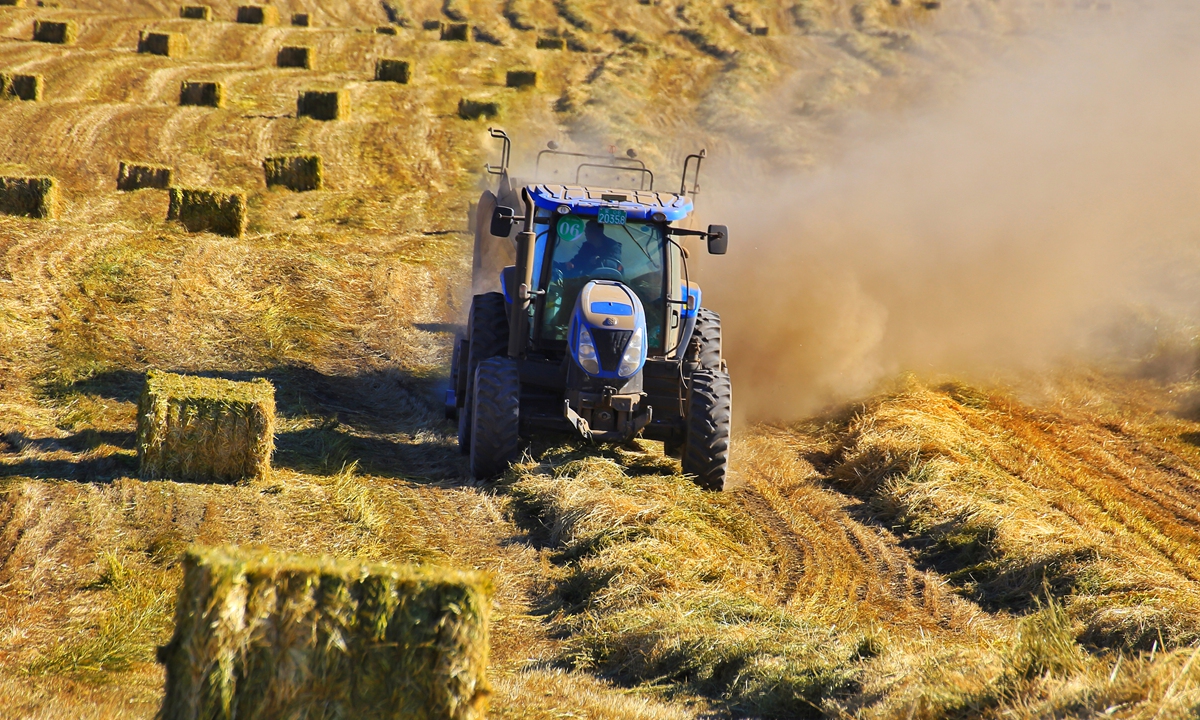
A hayfield in Northwest China's Gansu Province Photo: CFP
China's hay sector is coping with the impact of the halt of Australian hay imports by expanding domestic supplies and increasing imports from other sources, including the US, following trade tension between China and Australia.
The 25 Australian businesses that export hay to China have failed to get their permits renewed since the end of February, becoming what media reports have dubbed as the latest casualty of the ongoing trade tensions.
The halt of Australian hay shipments has further tightened stockpiles and pushed market prices to record highs, with imported hay prices jumping by over 10 percent and the domestic hay price increasing around 20 percent from 1,700 yuan ($261) per ton in February to 2,100 yuan now.
"Higher prices were expected since Australia is the only source of imported hay at the moment, providing about one-third of China's consumption," a general manager with a large Beijing-based hay trading and producing company surnamed Wang told the Global Times on Tuesday.
The tightened supplies have reduced stockpiles. "Our supplies will dry up within a month and we cannot find immediate new supplies yet," said Wang.
Wang is expanding hay imports from the US and Canada, but these countries offer timothy hay, not oat, and this is different from Australian hay in terms of quality.
Even with these alternatives, it will take about a year to determine the possible effect of feeding the hay to cattle before it is put into use in large quantities, said Wang.
The president of one of the largest domestic hay producers in North China's Inner Mongolia Autonomous Region, surnamed Li, told the Global Times on Tuesday that soaring demand has cut into the company's inventory, leaving only around few thousand tons of hay.
But the impact will be temporary because the company has diversified its products, not just to different kinds of hay but also corn straw to feed cattle. The quality of corn straw is lower than that of hay, but it can be a temporary alternative.
"We are expecting a new crop of hay to be harvested in June to help to ease tightened supplies," said Li.
The company also expanded its planting area by adding 70,000 mu (4,666 hectares) of oat grass in Bashang grassland in North China's Hebei Province and in Baotou, Inner Mongolia Autonomous Region. These crops are expected to be harvested in September.
The quality of the domestic hay is comparable to imported types, although the sugar content is slightly lower. The fiber content is high, which is an important indicator of quality, industry insiders said. Domestic hay is also cheaper to produce, which helps it gain popularity over imported crops.
Hay consumption in China is significant -- about 1 million tons annually -- and the number is still increasing with the rising consumption of meat and dairy products.
Data from market information online platform Qichacha showed that there were 235 hay-growing enterprises as of Tuesday, with 21 newcomers so far this year, which experts said is a significant increase for the niche industry.
Experts said that the current situation is a lesson about depending too much on a single source.
"Since the China-Australia Free Trade Agreement started taking in effect in December 2015, economic and trade relations between the two countries have become increasingly interdependent.
"The Chinese market has been importing hay from Australia for a long time, which objectively forms the problem of a single supply chain," Song Wei, an associate research fellow at the Chinese Academy of International Trade and Economic Cooperation, told the Global Times on Tuesday.
The negative impact of China-Australian economic and trade friction is expanding, and more goods from Australian will run into hurdles if bilateral relations continue to deviate from the right track, the expert said.
"In the future, with the signing of the RCEP and the high-quality development of the Belt and Road, our supply chain and value chain will continue to diversify," said Song.


